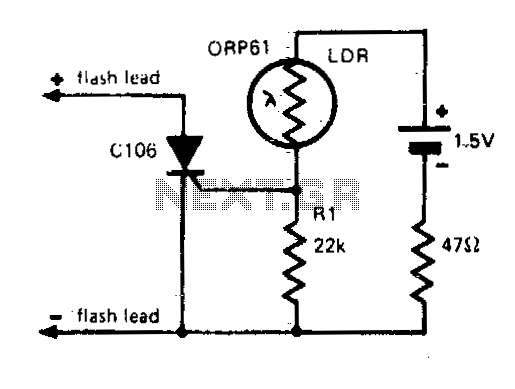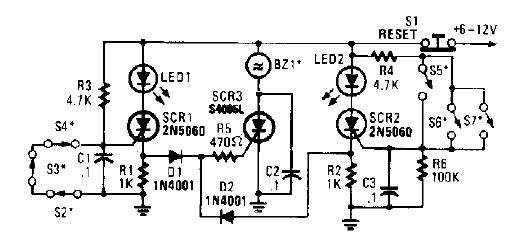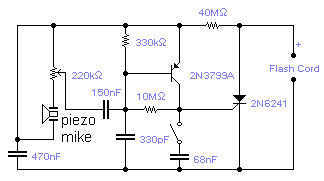
Flash slave driver

In photography, a separate flash, triggered by the light of a master flash, is often required to provide additional light and fill in shadows. The sensitivity of this circuit depends on the proximity of the master flash and the value of Rl. Increasing Rl results in increased sensitivity.
In a typical photography setup that utilizes a master flash and a secondary flash, the triggering mechanism is essential for achieving optimal lighting conditions. The master flash, which is the primary light source, emits a burst of light that activates the secondary flash. This configuration is particularly useful in scenarios where additional illumination is necessary to enhance the overall exposure and reduce unwanted shadows.
The sensitivity of the triggering circuit is influenced by the distance between the master flash and the secondary flash. This sensitivity can be adjusted by varying the resistance value of Rl. A higher resistance value leads to increased sensitivity, allowing the secondary flash to be triggered even at greater distances from the master flash. Conversely, a lower resistance value decreases sensitivity, which may be suitable for closer distances.
To implement this circuit, a phototransistor or light-dependent resistor (LDR) can be used to detect the light from the master flash. The output from the phototransistor can be connected to a relay or a transistor switch that activates the secondary flash. The design should ensure that the triggering mechanism is responsive enough to capture the brief duration of the master flash while also being adjustable via Rl to accommodate various shooting conditions.
In summary, the interaction between the master flash and the secondary flash, modulated by the resistance value Rl, plays a crucial role in achieving effective lighting in photography. Proper circuit design and component selection are vital to ensure reliable performance across different lighting scenarios.In photography r a separate flash, triggered by the light of a master flash light, is often required to provide more light, fill-in shadows etc. The sensitivity of this circuit depends on the proximity of the master flash and the value of Rl Increasing Rl gives increased sensitivity. 🔗 External reference
In a typical photography setup that utilizes a master flash and a secondary flash, the triggering mechanism is essential for achieving optimal lighting conditions. The master flash, which is the primary light source, emits a burst of light that activates the secondary flash. This configuration is particularly useful in scenarios where additional illumination is necessary to enhance the overall exposure and reduce unwanted shadows.
The sensitivity of the triggering circuit is influenced by the distance between the master flash and the secondary flash. This sensitivity can be adjusted by varying the resistance value of Rl. A higher resistance value leads to increased sensitivity, allowing the secondary flash to be triggered even at greater distances from the master flash. Conversely, a lower resistance value decreases sensitivity, which may be suitable for closer distances.
To implement this circuit, a phototransistor or light-dependent resistor (LDR) can be used to detect the light from the master flash. The output from the phototransistor can be connected to a relay or a transistor switch that activates the secondary flash. The design should ensure that the triggering mechanism is responsive enough to capture the brief duration of the master flash while also being adjustable via Rl to accommodate various shooting conditions.
In summary, the interaction between the master flash and the secondary flash, modulated by the resistance value Rl, plays a crucial role in achieving effective lighting in photography. Proper circuit design and component selection are vital to ensure reliable performance across different lighting scenarios.In photography r a separate flash, triggered by the light of a master flash light, is often required to provide more light, fill-in shadows etc. The sensitivity of this circuit depends on the proximity of the master flash and the value of Rl Increasing Rl gives increased sensitivity. 🔗 External reference





